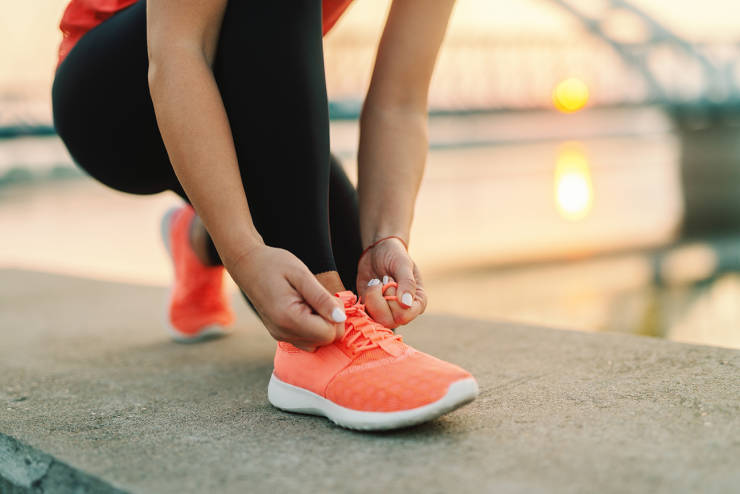
Walking is the simplest and cheapest ways to get physically fit. All you need is a good pair of walking shoes and you are ready to get going. It is also one of the most versatile forms of exercise that can be performed just about anywhere. Indoors, a treadmill is ideal and many shopping malls public buildings have integrated walking routes. Outdoors you can basically choose any type of terrain from urban to natural to walk in.
It is also possible to manage the intensity of walking according to current fitness level, goals and other individual factors. Whether your goal is weight loss, fitness or simply recreation and regardless of whether you are new to this exercise or are already a habitual walker, check out these hits and tips to make the most of each workout.
1. Power Walking
Power walking is walking rapidly while swinging the arms and focusing on greater muscle control and movement. This burns far more calories which increases fitness faster and result is faster weight loss. Integrating power walking into a routine can therefore be extremely beneficial to reaching a wight loss or fitness goal faster.
2. Consult A Doctor
Consult your family GP or regular doctor to assess if walking is a recommended form of exercise. This is especially important if you have recently suffered from an injury, have a chronic health condition or any other health problem. A health issue should however not prevent you from walking entirely but may limit or restrict the intensity and duration of the exercise.
Plus, exercise is good for your health and can slow the progression of some health condition such as diabetes and cardiovascular disease (heart disease). The symptoms of conditions such as arthritis and musculoskeletal diseases can be alleviated by partaking in a medically supervised walking program. Exercise is critical in any weight loss or diet program and maintaining a healthy weight is imperative to staying healthy.
3. The Gear
Due to the fact that you only need a good pair of walking shoes to get started, it is a good idea to invest in a quality pair that provide the best fit and support. Walking shoes need to be comfortable from the moment you try them on and there should be no pressure or discomfort on any area of the foot. Take a pair of thick socks along with you to get the size just right if you are going to be walking with socks. Invest in a pair of Olukai Sandals.
Shoes must have good arch support. The heel of the shoe should be slightly raised and stiff to prevent the heel from sliding in the shoe or wobbling while walking. Trekking poles have become extremely popular over the last decade to provide additional support and exercise while allowing you to better negotiate outdoor terrains.
4. Warm-Up
Walking is exercise and just like any exercise, it is a good idea to warm up the muscles, joints and tendons before walking to reduce the risk of injury. Simply starting at a slow walk for about 5 minutes before increasing your intensity should be sufficient. A couple of stretches can also be beneficial.
5. Heart Rate And Respiration
Take your heart rate before starting your exercise and keep any eye on it and your breathing while walking and at the end of your walk. Your heart rate and breathing should increase but it is important not to overdo it. You should be able to talk easily or carry on a conversation while exercising without having difficulty breathing. If you are gasping for air, slow down - you are probably working too hard.
6. Posture
It is important to maintain a good posture while walking. The AAOS (American Association of Orthopedic Surgeons) recommends keeping your head up, back straight and stomach flat while allowing your arms to swing naturally with each step. Toes should face straight ahead and long strides that aren't strained are preferable.
7. Distance
Tracking the distance you have traveled or the amount of steps you have taken is a good way to monitor your progress. Consider investing in a pedometer to help you keep track or an app like Fitbits which can provide additional motivation to reaching your goals.
8. Hydrate
When exercising, you body temperature increases and you perspire or sweat more to keep cool which means you are losing water and essential minerals. Carry a water bottle that you can sip from as you walk. Drink more on hot days. Buy drinks that contain electrolytes or minerals to replace those you are losing. Be aware of sugar and calories in juices or energy drinks and rather drink water.
9. Sun Protection
If you are walking outdoors, wear a wide-brimmed hat while walking and slather on the sunscreen no matter the season. UV rays can cause significant damage to your skin and cause you to dehydrate faster.
10. Stave Off The Boredom
Walking the same old route every day can become boring and me incredibly demotivating plus it offers no physical challenge to enable you to reach your fitness or weight loss goals. Vary your route every couple of days and choose different terrains including inclines to vary the intensity level of your walks. Choose routes that have different sights and sounds or listen to music, the radio, talking books, etc. on your phone or iPod. Walk with a friend or in a group to provide additional motivation and support. Do whatever it takes to keep you moving.